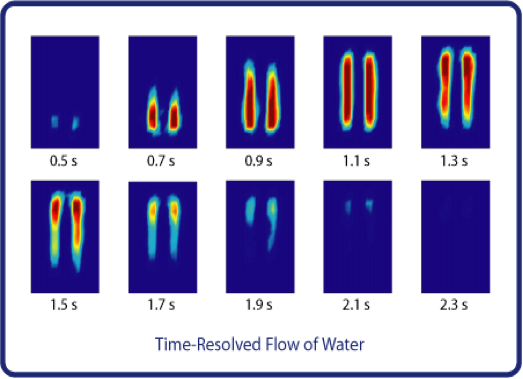
The atomic magnetometer is suited for remote detection of NMR and MRI, as demonstrated with these magnetic resonance images capturing the flow of water through two microfluidic channels. A paired magnetometer configuration dramatically improved the signal-to-noise ratio, enabling the researchers to detect an MRI signal from microliters of water in 0.1 second without the presence of a strong magnet.
APPLICATIONS OF TECHNOLOGY:
- Low-cost MRI for noninvasive diagnostics
- Remote medical diagnostic detection by NMR and MRI
- Monitoring chemical reactions and biological processes using magnetic particles
- Detecting magnetic impurities for quality control on production lines
- Enabling studies of drug delivery for pharmaceutical development
ADVANTAGES:
- High sensitivity to weak magnetic fields at room temperature
- Low initial cost, inexpensive to maintain
- Portable, with compact electronics for multi-channel imaging
- Allows high-throughput, continuous sample monitoring
- No cryogenics necessary
- Sensors are at room temperature; lasers are low power
- Ideal for situations in which conventional MRI is not possible
ABSTRACT:
Magnetic resonance imaging (MRI) is a powerful tool for noninvasive diagnostics, but the multimillion dollar cost of an MRI machine severely limits the number of them in use and their accessibility to less well funded clinical facilities. What is needed is an alternative MRI technology that is compact and portable while also being inexpensive to build and maintain.
Low-Cost MRI Detection
The most expensive requirement for MRI is the cryogenic high-field magnet, which is used both to polarize the sample and to help detect the image. The stronger the magnetic field, the stronger the signal, which is why large and expensive magnets are required to generate a sufficient signal for conventional MRI. Now, Shoujun Xu, Dmitry Budker, Alexander Pines, and their colleagues at Berkeley Lab have created a highly sensitive laser-based optical atomic magnetometer to detect NMR/MRI, as well as magnetic microparticles and nanoparticles, at room temperature without a high-field magnet.
The new laser-based approach to MRI physically separates the signal encoding and detection steps of MRI, allowing both to be optimized for sensitivity. This advance is combined with the new atomic magnetometer, which uses a phenomenon known as “nonlinear magneto-optical rotation.” Alkali atoms featuring a single unpaired electron are vaporized in a glass cell. The unpaired electron makes the atoms themselves act like spinning bar magnets. A laser beam then “pumps” the atoms so that their spins are polarized, then “probes” the atoms for an MRI signal.
Atomic magnetometers are convenient and cheap to operate because they do not require cryogenics and their electronics can be made compact and portable for multi-channel imaging. Their high sensitivity is comparable to the best current detection methods using superconducting quantum interference devices (SQUIDs). SQUIDs are finicky devices, quite susceptible to stray magnetic fields, and require sophisticated electronics with cryogenic cooling because they use quantum effects that only exist in superconductors. Giant magnetoresistive (GMR) sensors are another current detection method, but they are three orders of magnitude less sensitive than SQUIDs or atomic magnetometers.
Technologies with lower sensitivity require positioning of a test sample as close as possible to the sensors—usually within several micrometers—which is not practical for applications such as monitoring large volumes of samples for security checks, or for monitoring drug delivery or biological processes for medical purposes. In addition, the new optical atomic magnetometer separates image encoding and detection so that a larger region can be imaged without loss of sensitivity.
Where No MRI Has Gone Before
With its portability, low cost, and outstanding sensitivity in low magnetic fields, MRI using an atomic magnetometer is ideal for many situations in which conventional MRI is not possible.
Due to the low magnetic fields used with atomic magnetometers, samples that are problematic for normal MRI detection methods, such as medical imaging in the presence of metal implants, will no longer present a problem. Remote MRI of the flow and reactions of fluids is also possible without disturbing ongoing chemical or biochemical reactions.
Magnetic Microparticle Detection
The Berkeley Lab optical atomic magnetometer also has applications besides MRI. Micrometer- and nanometer-sized magnetic particles add a controllable dimension to various biological and medical processes, such as magnetic imaging, controlled drug delivery, hyperthermia treatment of certain cancers, cell separation, and protein labeling. The location and dynamics of these magnetic particles can be adjusted by external magnetic fields, but their weak magnetic fields have always made detection challenging with MRI, GMR, or SQUIDs.
The ultra-high sensitivity of atomic magnetometers makes it possible to detect, at room temperature, even tiny amounts of magnetic particles. This will allow a greater number of applications involving the continuous handling of large volumes of samples, including security checks or in-line product quality control.
STATUS:
- Issued Patent 7,573,264. Available for licensing or collaborative research.
To learn more about licensing a technology from LBNL see here.
FOR MORE INFORMATION:
“MRI On the Cheap and Go,” Research/News, Berkeley Labs, 02/07/2008
REFERENCE NUMBER: IB-2232
SEE THESE OTHER BERKELEY LAB TECHNOLOGIES IN THIS FIELD:
- Mobile Ex-Situ High Resolution NMR and MRI, IB-1717
- Portable, High Resolution NMR/MRI in Inhomogeneous Fields, IB-2185
- SQUID-Detected NMR and MRI at Ultralow Magnetic Fields, IB-1729
- Low-field NMR/MRI Using Rotating-Frame Gradient Fields, IB-2288